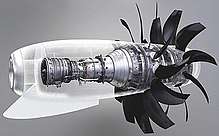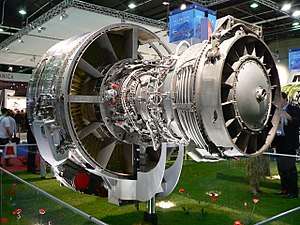Safran Aircraft Engines
 | |
| Subsidiary | |
| Industry |
Aerospace Defence |
| Founded | 1945 |
| Headquarters | Courcouronnes, France |
Key people | Olivier Andriès (CEO) |
| Products |
Aircraft engines Rocket engines |
| Revenue |
|
|
| |
Number of employees | 15,700 (2016) |
| Parent | Safran |
| Website |
www |
Safran Aircraft Engines (previously Snecma) is a French aerospace engine manufacturer headquartered in Courcouronnes, France. It designs, makes and maintains engines for commercial and military aircraft as well as rocket engines for launch vehicles and satellites.
Some of its notable past developments, alone or in partnership, include the M88 for the Rafale, Olympus 593 for the Concorde, CFM56/CFM-LEAP for single-aisle airliners, and the Vulcain engines for the Ariane 5.
It has 15,700 employees working at 35 production sites, offices, and MRO facilities worldwide. It files an average of nearly 500 patents each year.
Safran Aircraft Engines is a subsidiary of Safran.
History
- 1945: Snecma was formed when the French aircraft engine manufacturer Gnome & Rhône was nationalised. The name 'Snecma' was an acronym for Société nationale d'études et de construction de moteurs d'aviation (in English: 'National Company of Research and Construction of Aviation Engines').
- 1946 or 1947, the nationalized Régnier Motor Company was absorbed into Snecma and continued to produce the SNECMA Régnier 4L.
- 1961: Snecma and Bristol Siddeley formed a joint venture to produce a high-performance jet engine for the Concorde. The main body of the engine came from the Bristol Olympus, which was further improved with several refinements including the addition of the variable intakes necessary for supersonic flight.
- 1968: Snecma acquired Hispano-Suiza, Socata and Bugatti.
- 1970: Messier and Snecma agreed to merge their landing gear business. The following year, Messier-Hispano was formed, which was fully acquired by Snecma in 1973. Snecma's landing gear business was further consolidated by the creation of Messier-Hispano-Bugatti (later renamed Messier-Bugatti) in 1977.
- 1974: Snecma and General Electric (GE) created a joint venture named CFM International, beginning a long term cooperation to produce the CFM56 series of turbofan engines.
- 1990: Snecma announced its partnership with General Electric to build and produce the General Electric GE90 engine.
- 1994: Messier-Dowty was formed following the merger of the landing gear businesses of Snecma (Messier) and the British TI Group (Dowty).
- 1997: Snecma fully acquired the Société européenne de propulsion.[2]
- 1998: Snecma took full control of Messier-Dowty.
- 1999: Snecma Services was created to consolidate all maintenance, repair and overhaul (MRO) operations (including Sochata-Snecma).
- 2000: Snecma acquired Labinal, along with its Turbomeca and Microturbo subsidiaries.
- 2001: Hurel-Hispano (now renamed and known as Safran Nacelles) was created to consolidate the group's engine nacelle and thrust reverser business.
- 2005: Snecma merged with Sagem to form Safran. Snecma was divided into two divisions of the new group (propulsion and equipment).
- 2010: Snecma and GE formed CFM Materials as a 50/50 joint venture.
- 2016: Snecma was renamed Safran Aircraft Engines as the main subsidiary of Safran.
Research

The European Commission launched in 2008 an open rotor demonstration led by Safran within the Clean Sky program with 65 million euros funding over eight years : a demonstrator was assembled in 2015, and ground tested in May 2017 on its open-air test rig in Istres, aiming to reduce fuel consumption and associated CO2 emissions by 30% compared with current CFM56 turbofans.[3] With its 30:1 bypass ratio, it should deliver a 15% improvement over the CFM LEAP already at 11:1; but Airbus is more interested in the more conventional Ultra High Bypass Ratio (UHBR) turbofan at 15:1, which could be introduced from 2025, offering 5% to 10% better efficiency than the LEAP and to be tested from 2020.[4]
The gearbox and the blade variable-pitch technologies were validated in 100 cycles and 70 hours of tests, including 25% at takeoff thrusts of 21,000–25,000 lbf (93–111 kN), reverse thrust, and rotor imbalance with a blade weight. Afterwards, it was disassembled in April 2018 to examine each part and refine expected wear predictions. GE Aviation was involved through its Italian subsidiary Avio Aero, providing the gearbox and the low-pressure turbine. To be certified, a blade-out event have to be extremely improbable, less than once every billion flight hours as its RTM carbon fiber fan blades will be supported by the in-service LEAP experience.[5]
Products

The company's major commercial aircraft engine is the CFM International CFM56. Produced by a 50-50 partnership with General Electric, 30,000 CFM56s have been built as of July 2016.[6]
Safran Aircraft Engines is also the main partner for the General Electric CF6-80 and GE90 programs. It is also involved in the high-thrust turbofan business as part of the Engine Alliance GP7000 program, which produces one of the only two engines certified to power the Airbus A380.
Through the PowerJet partnership with NPO Saturn of Russia, Safran Aircraft Engines also produces SaM146 engines for the Sukhoi Superjet 100.
Aircraft
Commercial engines
- CFM International CFM56 (50%)
- CFM International LEAP (50%)
- PowerJet SaM146 (50%)
- General Electric GE90 (23.5%)
- General Electric CF6 (10–20% share of production, depending on engine model)
- Engine Alliance GP7000 (10%)
- Safran Silvercrest (under development)
- 5,000 shp turboprop (under study) for 70–90 seater regional airliners[7][8]
Military engines
Space engines
Sites
References
- 1 2 "Safra SA 2016" (PDF).
- ↑ "Societe Europeenne De Propulsion (France)". Jane's Space Systems and Industry. 12 April 2005. Retrieved 18 March 2009.
- ↑ "Safran celebrates successful start of Open Rotor demonstrator tests on new open-air test rig in southern France" (Press release). Safran. October 3, 2017.
- ↑ Guillaume Lecompte-Boinet (October 4, 2017). "Safran Inaugurates Open-rotor Test Program". AIN.
- ↑ Thierry Dubois (Apr 5, 2018). "Safran Says Counter-Rotating Open Rotor Engine Relevant". Aviation Week & Space Technology.
- ↑ "30,000th CFM56 engine comes off the production-line" (Press release). CFM international. 12 July 2016.
- ↑ "Safran Reveals New Turboprop Efforts". Aviation Week. 1 May 2013. Retrieved 4 August 2013.
- ↑ "Safran veut s'attaquer au monopole de Pratt & Whitney" (in French). aerobuzz.fr. 24 January 2012. Archived from the original on 6 August 2013. Retrieved 4 August 2013.
- Gunston, Bill (2006). World Encyclopedia of Aero Engines, 5th Edition. Phoenix Mill, Gloucestershire, England, UK: Sutton Publishing Limited. ISBN 0-7509-4479-X.
External links
| Wikimedia Commons has media related to Snecma. |
.jpg)